An Active Electromagnetically Induced Transparency (EIT) Metamaterial Based on Conductive Coupling
Abstract
:1. Introduction
2. Materials and Methods
3. Results
4. Conclusions
Author Contributions
Funding
Institutional Review Board Statement
Informed Consent Statement
Data Availability Statement
Conflicts of Interest
References
- Boller, K.-J.; Imamoğlu, A.; Harris, S.E. Observation of electromagnetically induced transparency. Phys. Rev. Lett. 1991, 66, 2593–2596. [Google Scholar] [CrossRef] [PubMed] [Green Version]
- Harris, S.E. Electromagnetically Induced Transparency. Phys. Today 1997, 50, 36–42. [Google Scholar] [CrossRef]
- Soljačić, M.; Joannopoulos, J.D. Enhancement of nonlinear effects using photonic crystals. Nat. Mater. 2004, 3, 211–219. [Google Scholar] [CrossRef] [PubMed]
- Wang, C.; Jiang, X.; Zhao, G.; Zhang, M.; Hsu, C.W.; Peng, B.; Stone, A.D.; Jiang, L.; Yang, L. Electromagnetically induced transparency at a chiral exceptional point. Nat. Phys. 2020, 16, 334–340. [Google Scholar] [CrossRef] [Green Version]
- Kang, Y.; Xi, H.; Meng, T.; Lin, Q.; Dong, L. Experimental demonstration of polarization and direction insensitive metamaterial analog of electromagnetically induced transparency by bright-bright mode coupling. Results Phys. 2022, 37, 105514. [Google Scholar] [CrossRef]
- Wang, Z.; Shao, J.; Hu, Y.; Zhu, J.; Zhang, X.; Bai, L.; Dong, Z. Electromagnetically Induced Transparency Based on All-Dielectric Metamaterial with High Q Factor. Acta Opt. Sin. 2021, 41, 1116001. [Google Scholar]
- Rao, S.J.M.; Srivastava, Y.K.; Kumar, G.; Chowdhury, D.R. Modulating Fundamental Resonance in Capacitive Coupled Asymmetric Terahertz Metamaterials. Sci. Rep. 2018, 8, 16773. [Google Scholar] [CrossRef] [Green Version]
- Zhang, M.; Zhang, W.; Liu, A.Q.; Li, F.C.; Lan, C.F. Tunable Polarization Conversion and Rotation based on a Reconfigurable Metasurface. Sci. Rep. 2017, 7, 12068. [Google Scholar] [CrossRef] [Green Version]
- Song, Q.; Zhang, W.; Wu, P.C.; Zhu, W.; Shen, Z.X.; Chong, P.H.J.; Liang, Q.X.; Yang, Z.C.; Hao, Y.L.; Cai, H.; et al. Water-Resonator-Based Metasurface: An Ultrabroadband and Near-Unity Absorption. Adv. Opt. Mater. 2017, 5, 1601103. [Google Scholar] [CrossRef]
- Yan, C.; Li, X.; Pu, M.; Ma, X.; Zhang, F.; Gao, P.; Liu, K.; Luo, X. Midinfrared real-time polarization imaging with all-dielectric metasurfaces. Appl. Phys. Lett. 2019, 114, 161904. [Google Scholar] [CrossRef]
- Long, Z.; Liang, Y.; Feng, L.; Zhang, H.; Liu, M.; Xu, T. Low-cost and high sensitivity glucose sandwich detection using a plasmonic nanodisk metasurface. Nanoscale 2020, 12, 10809–10815. [Google Scholar] [CrossRef] [PubMed]
- Chen, M.Z.; Tang, W.; Dai, J.Y.; Ke, J.C.; Zhang, L.; Zhang, C.; Yang, J.; Li, L.; Cheng, Q.; Jin, S.; et al. Accurate and broadband manipulations of harmonic amplitudes and phases to reach 256 QAM millimeter-wave wireless communications by time-domain digital coding metasurface. Natl. Sci. Rev. 2021, 9, nwab134. [Google Scholar] [CrossRef] [PubMed]
- Papasimakis, N.; Fedotov, V.A.; Zheludev, N.I.; Prosvirnin, S.L. Metamaterial Analog of Electromagnetically Induced Transparency. Phys. Rev. Lett. 2008, 101, 253903. [Google Scholar] [CrossRef] [Green Version]
- Papasimakis, N.; Fu, Y.H.; Fedotov, V.A.; Prosvirnin, S.L.; Tsai, D.P.; Zheludev, N.I. Metamaterial with polarization and direction insensitive resonant transmission response mimicking electromagnetically induced transparency. Appl. Phys. Lett. 2009, 94, 211902. [Google Scholar] [CrossRef] [Green Version]
- Zhang, L.; Tassin, P.; Koschny, T.; Kurter, C.; Anlage, S.M.; Soukoulis, C.M. Large group delay in a microwave metamaterial analog of electromagnetically induced transparency. Appl. Phys. Lett. 2010, 97, 241904. [Google Scholar] [CrossRef] [Green Version]
- Chiam, S.-Y.; Singh, R.; Rockstuhl, C.; Lederer, F.; Zhang, W.; Bettiol, A.A. Analogue of electromagnetically induced transparency in a terahertz metamaterial. Phys. Rev. B 2009, 80, 153103. [Google Scholar] [CrossRef] [Green Version]
- Liu, T.; Wang, H.; Liu, Y.; Xiao, L.; Zhou, C.; Liu, Y.; Xu, C.; Xiao, S. Independently tunable dual-spectral electromagnetically induced transparency in a terahertz metal–graphene metamaterial. J. Phys. D Appl. Phys. 2018, 51, 415105. [Google Scholar] [CrossRef] [Green Version]
- Liu, N.; Weiss, T.; Mesch, M.; Langguth, L.; Eigenthaler, U.; Hirscher, M.; Sönnichsen, C.; Giessen, H. Planar Metamaterial Analogue of Electromagnetically Induced Transparency for Plasmonic Sensing. Nano Lett. 2009, 10, 1103–1107. [Google Scholar] [CrossRef]
- He, X.-J.; Wang, L.; Wang, J.-M.; Tian, X.-H.; Jiang, J.-X.; Geng, Z.-X. Electromagnetically induced transparency in planar complementary metamaterial for refractive index sensing applications. J. Phys. D Appl. Phys. 2013, 46, 365302. [Google Scholar] [CrossRef]
- Zhang, J.; Mu, N.; Liu, L.; Xie, J.; Feng, H.; Yao, J.; Chen, T.; Zhu, W. Highly sensitive detection of malignant glioma cells using metamaterial-inspired THz biosensor based on electromagnetically induced transparency. Biosens. Bioelectron. 2021, 185, 113241. [Google Scholar] [CrossRef]
- Wang, J.; Yuan, B.; Fan, C.; He, J.; Ding, P.; Xue, Q.; Liang, E. A novel planar metamaterial design for electromagnetically induced transparency and slow light. Opt. Express 2013, 21, 25159–25166. [Google Scholar] [CrossRef] [PubMed]
- Wei, Z.; Li, X.; Zhong, N.; Tan, X.; Zhang, X.; Liu, H.; Meng, H.; Liang, R. Analogue Electromagnetically Induced Transparency Based on Low-loss Metamaterial and its Application in Nanosensor and Slow-light Device. Plasmonics 2016, 12, 641–647. [Google Scholar] [CrossRef]
- Cheng, Y.; Zhang, K.; Liu, Y.; Li, S.; Kong, W. Actively mode tunable electromagnetically induced transparency in a polarization-dependent terahertz metamaterial. AIP Adv. 2020, 10, 045026. [Google Scholar] [CrossRef] [Green Version]
- Pitchappa, P.; Manjappa, M.; Ho, C.P.; Singh, R.; Singh, N.; Lee, C. Active Control of Electromagnetically Induced Transparency Analog in Terahertz MEMS Metamaterial. Adv. Opt. Mater. 2016, 4, 541–547. [Google Scholar] [CrossRef]
- Huang, Y.; Nakamura, K.; Takida, Y.; Minamide, H.; Hane, K.; Kanamori, Y. Actively tunable THz filter based on an electromagnetically induced transparency analog hybridized with a MEMS metamaterial. Sci. Rep. 2020, 10, 20807. [Google Scholar] [CrossRef]
- Chen, M.; Xiao, Z.; Lv, F.; Cui, Z.; Xu, Q. Dynamically tunable dual-band electromagnetically induced transparency-like in terahertz metamaterial. Opt. Mater. 2020, 107, 110060. [Google Scholar] [CrossRef]
- Deng, Y.; Song, Z. Manipulating polarization and electromagnetically induced transparency in a switchable metamaterial. Opt. Mater. 2020, 105, 109972. [Google Scholar] [CrossRef]
- Song, Z.; Chen, A.; Zhang, J.; Wang, J. Integrated metamaterial with functionalities of absorption and electromagnetically induced transparency. Opt. Express 2019, 27, 25196–25204. [Google Scholar] [CrossRef]
- Cai, W.; Xiao, B.; Yu, J.; Xiao, L. A compact graphene metamaterial based on electromagnetically induced transparency effect. Opt. Commun. 2020, 475, 126266. [Google Scholar] [CrossRef]
- He, X.; Yang, X.; Lu, G.; Yang, W.; Wu, F.; Yu, Z.; Jiang, J. Implementation of selective controlling electromagnetically induced transparency in terahertz graphene metamaterial. Carbon 2017, 123, 668–675. [Google Scholar] [CrossRef]
- Jung, H.; Jo, H.; Lee, W.; Kim, B.; Choi, H.; Kang, M.S.; Lee, H. Electrical Control of Electromagnetically Induced Transparency by Terahertz Metamaterial Funneling. Adv. Opt. Mater. 2019, 7, 1801205. [Google Scholar] [CrossRef]
- Kurter, C.; Tassin, P.; Zhang, L.; Koschny, T.; Zhuravel, A.P.; Ustinov, A.V.; Anlage, S.M.; Soukoulis, C.M. Classical Analogue of Electromagnetically Induced Transparency with a Metal-Superconductor Hybrid Metamaterial. Phys. Rev. Lett. 2011, 107, 043901. [Google Scholar] [CrossRef] [PubMed] [Green Version]
- Zhang, Y.; Li, C.; Tu, X. Tuning Electromagnetically Induced Transparency of Superconducting Metamaterial Analyzed With Equivalent Circuit Approach. Prog. Electromagn. Res. M 2020, 91, 29–37. [Google Scholar] [CrossRef]
- Fan, Y.; Qiao, T.; Zhang, F.; Fu, Q.; Dong, J.; Kong, B.; Li, H. An electromagnetic modulator based on electrically controllable metamaterial analogue to electromagnetically induced transparency. Sci. Rep. 2017, 7, 40441. [Google Scholar] [CrossRef] [Green Version]
- Meng, D.; Wang, S.; Sun, X.; Gong, R.; Chen, C. Actively bias-controlled metamaterial to mimic and modulate electromagnetically induced transparency. Appl. Phys. Lett. 2014, 104, 261902. [Google Scholar] [CrossRef]
- Vovchuk, D.; Haliuk, S.; Robulets, P. Development of Frequency Modulator with SplitRing Resonator Loaded by Varactor Diode. In Proceedings of the 2020 IEEE 15th International Conference on Advanced Trends in Radioelectronics, Telecommunications and Computer Engineering (TCSET), Lviv-Slavske, Ukraine, 25–29 February 2020; pp. 536–539. [Google Scholar]
- Nakanishi, T.; Otani, T.; Tamayama, Y.; Kitano, M. Storage of electromagnetic waves in a metamaterial that mimics electromagnetically induced transparency. Phys. Rev. B 2013, 87, 161110. [Google Scholar] [CrossRef] [Green Version]
- Fu, Q.; Zhang, F.; Fan, Y.; Dong, J.; Cai, W.; Zhu, W.; Chen, S.; Yang, R. Weak coupling between bright and dark resonators with electrical tunability and analysis based on temporal coupled-mode theory. Appl. Phys. Lett. 2017, 110, 221905. [Google Scholar] [CrossRef]
- Zhang, X.G.; Yu, Q.; Jiang, W.X.; Sun, Y.L.; Bai, L.; Wang, Q.; Qiu, C.-W.; Cui, T.J. Polarization-Controlled Dual-Programmable Metasurfaces. Adv. Sci. 2022, 7, 1903382. [Google Scholar] [CrossRef]
- Liu, N.; Langguth, L.; Weiss, T.; Kästel, J.; Fleischhauer, M.; Pfau, T.; Giessen, H. Plasmonic analogue of electromagnetically induced transparency at the Drude damping limit. Nat. Mater. 2009, 8, 758–762. [Google Scholar] [CrossRef]
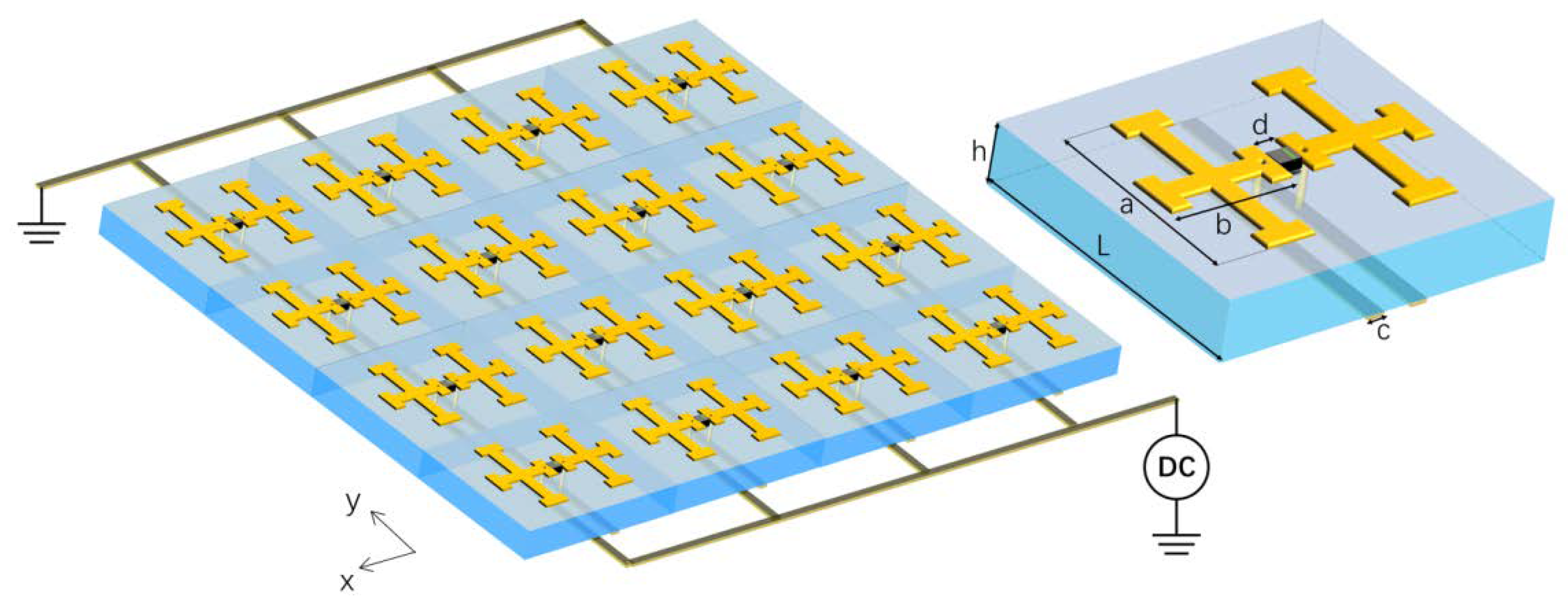
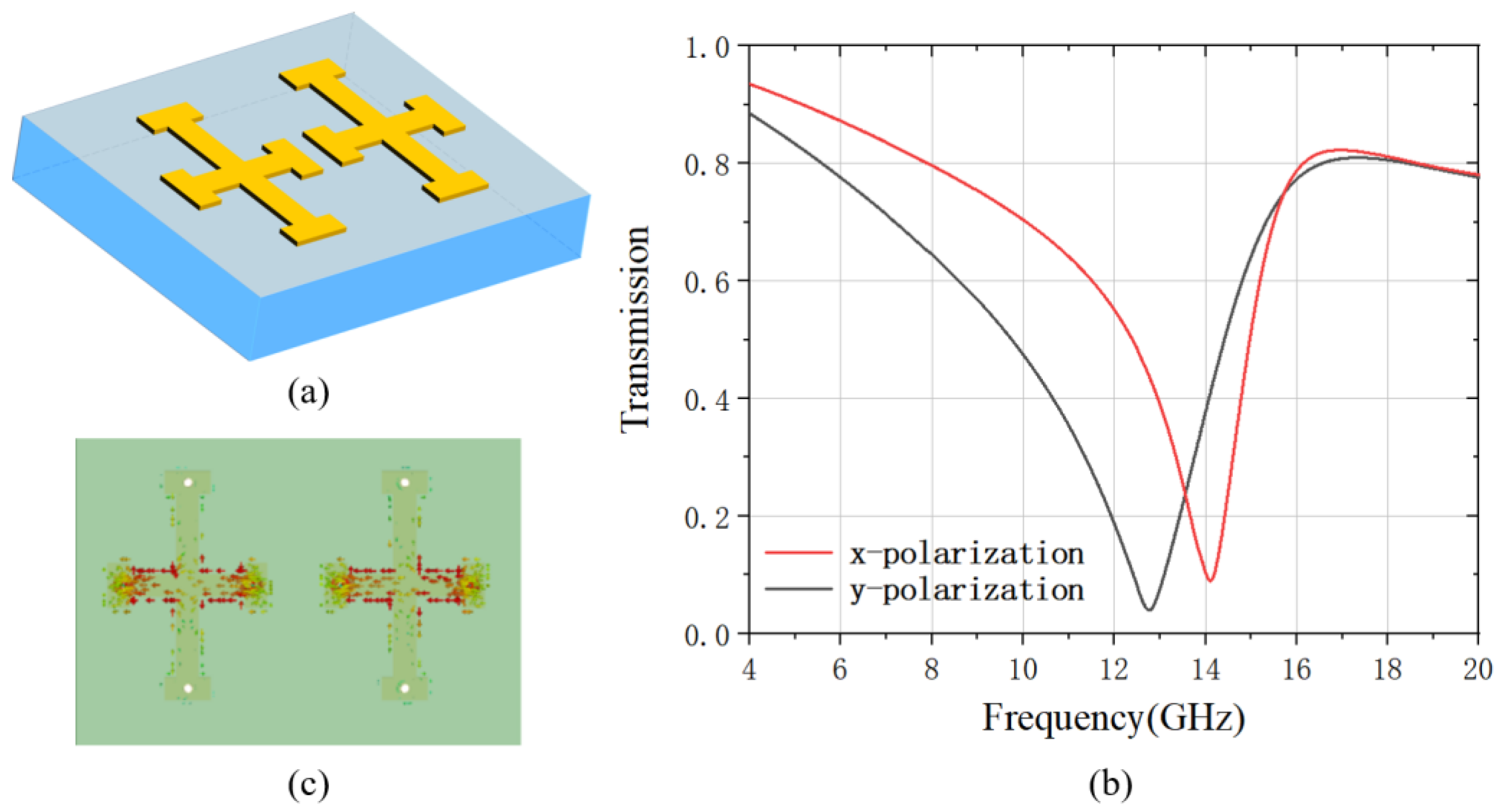
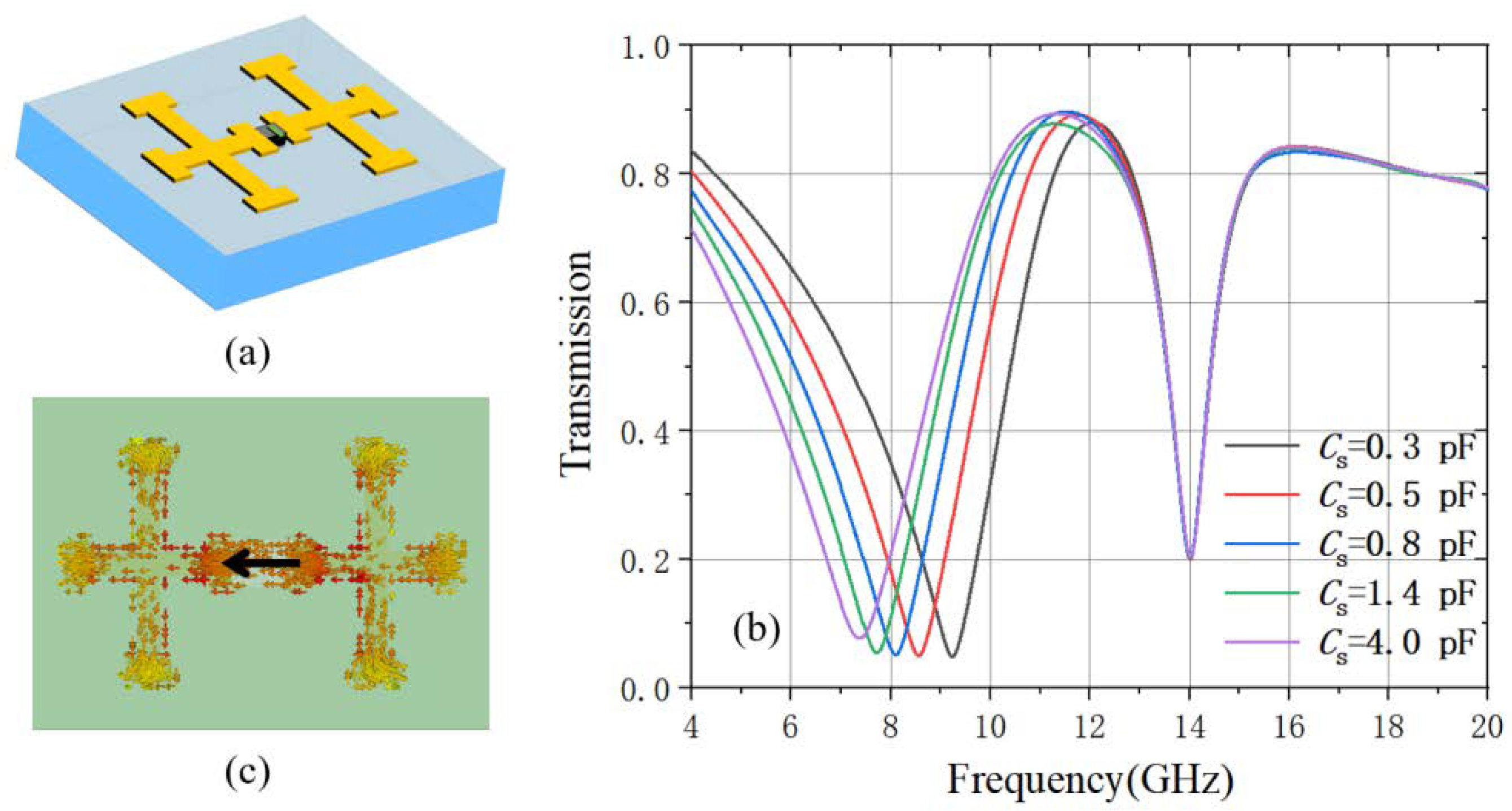
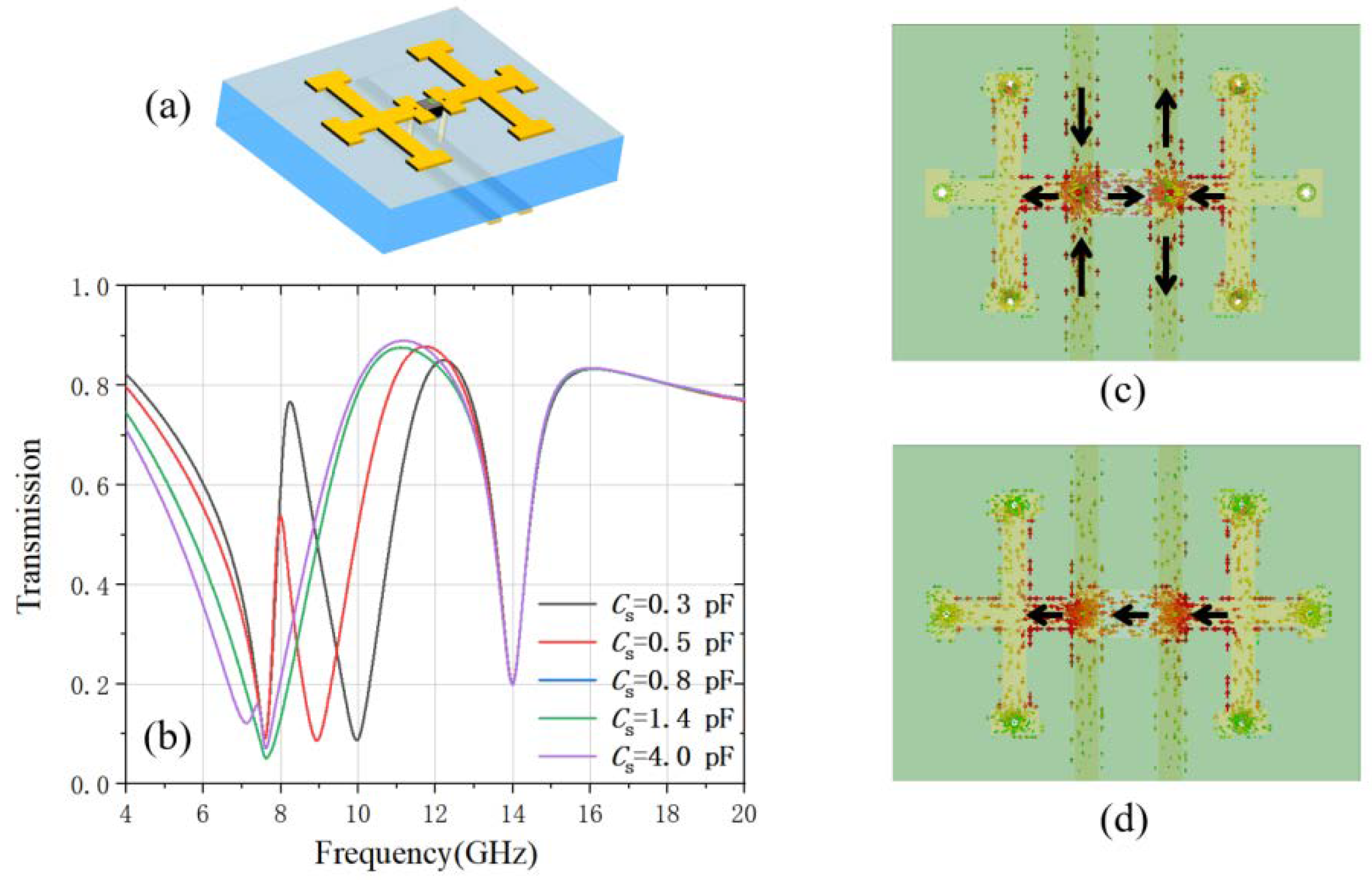
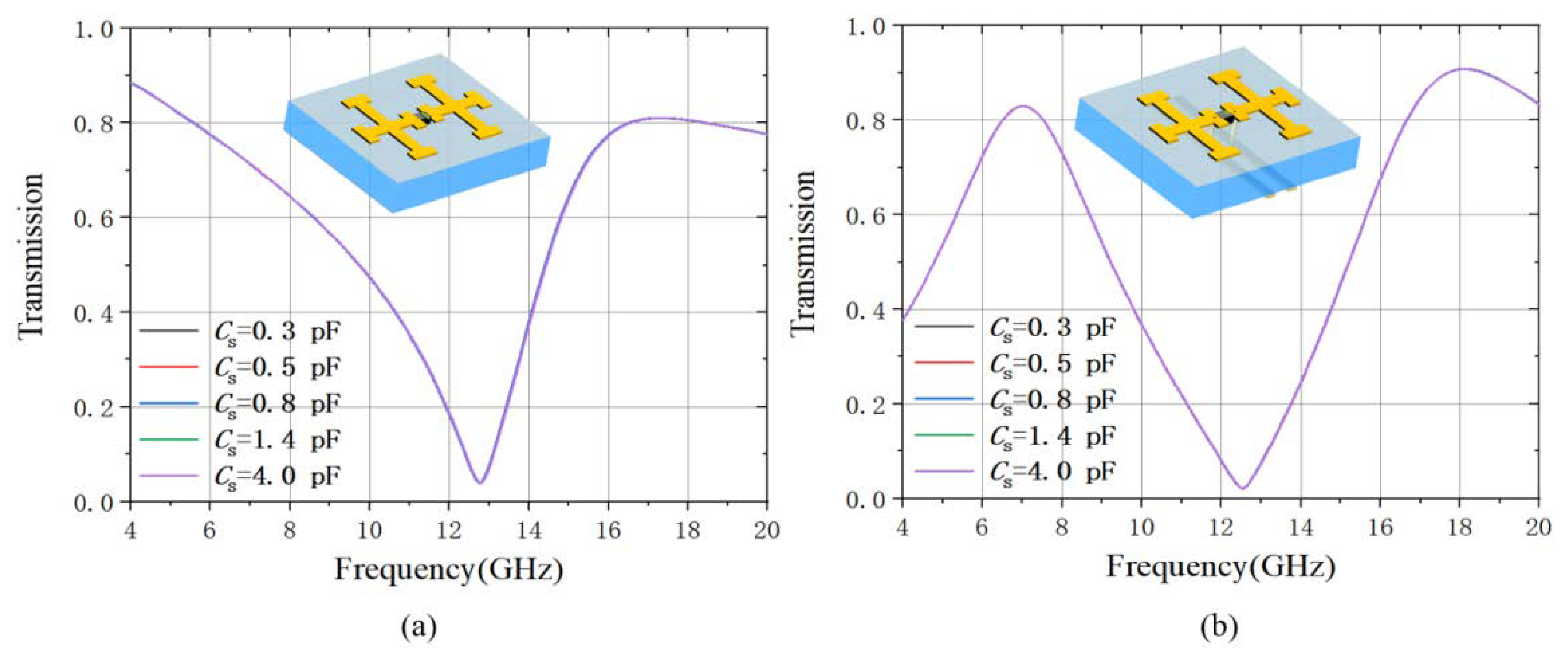
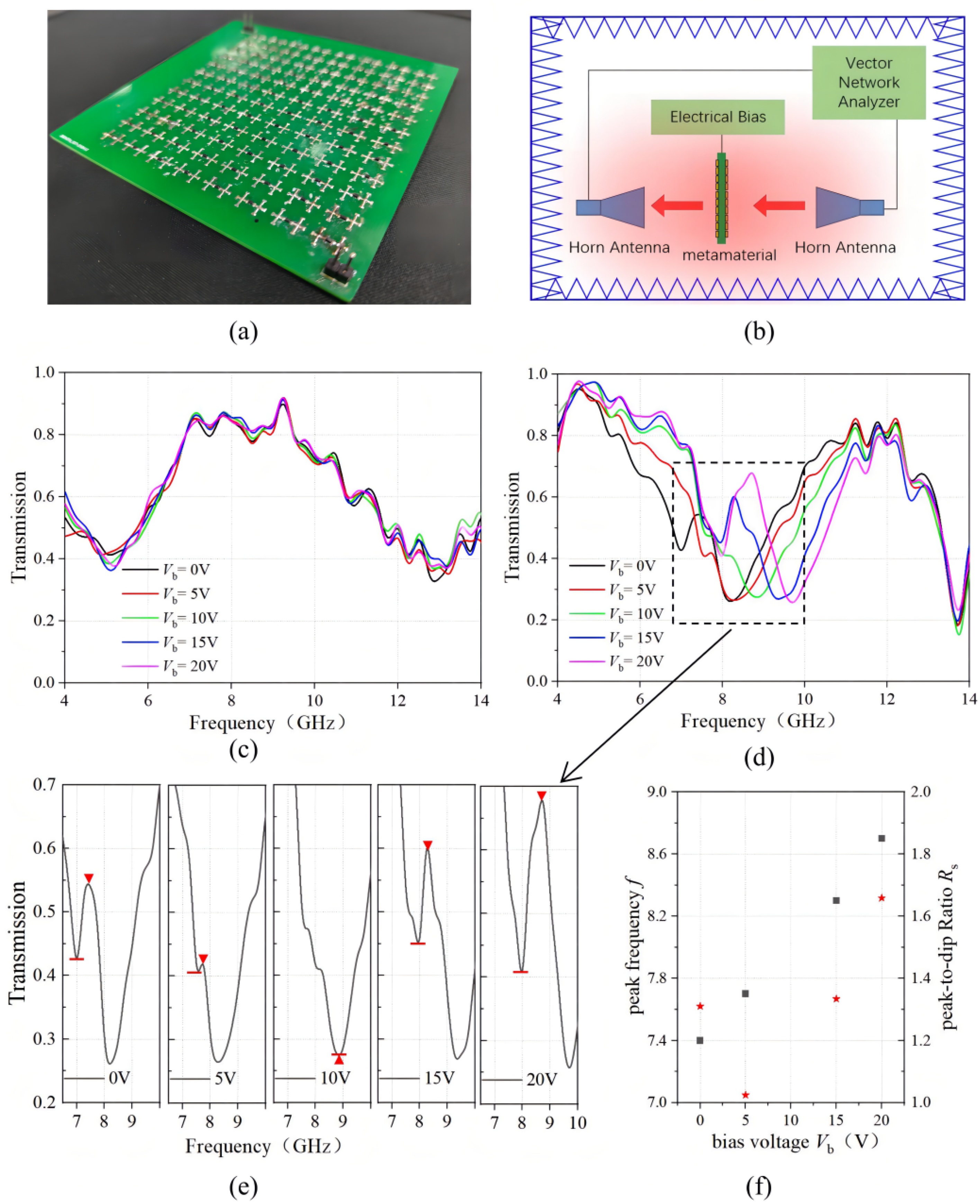
| bias Voltage | 0 V | 5 V | 10 V | 15 V | 20 V |
|---|---|---|---|---|---|
| capacitance | 3.20 pF | 1.19 pF | 0.57 pF | 0.41 pF | 0.35 pF |
| References | Diode Type | Single Cell/Array | Transmittance Change | Peak Frequency (GHz) | |
|---|---|---|---|---|---|
| [34] | PIN | single unit cell | Yes | 5.25 | 0 |
| [35] | PIN | unit cell array | Yes | 6.28 | 0 |
| [37] | varactor | single unit cell | Yes | 1.41~1.54 | 8.7% |
| [38] | varactor | single unit cell | Yes | 3.04~3.26 | 7.0% |
| our work | varactor | unit cell array | Yes | 7.4~8.7 | 16.1% |
Publisher’s Note: MDPI stays neutral with regard to jurisdictional claims in published maps and institutional affiliations. |
© 2022 by the authors. Licensee MDPI, Basel, Switzerland. This article is an open access article distributed under the terms and conditions of the Creative Commons Attribution (CC BY) license (https://creativecommons.org/licenses/by/4.0/).
Share and Cite
Zhang, W.; Lin, J.; Fang, X.; Lin, Y.; Wang, K.; Zhang, M. An Active Electromagnetically Induced Transparency (EIT) Metamaterial Based on Conductive Coupling. Materials 2022, 15, 7371. https://doi.org/10.3390/ma15207371
Zhang W, Lin J, Fang X, Lin Y, Wang K, Zhang M. An Active Electromagnetically Induced Transparency (EIT) Metamaterial Based on Conductive Coupling. Materials. 2022; 15(20):7371. https://doi.org/10.3390/ma15207371
Chicago/Turabian StyleZhang, Wu, Jiahan Lin, Xiaohui Fang, Yanxiao Lin, Kai Wang, and Meng Zhang. 2022. "An Active Electromagnetically Induced Transparency (EIT) Metamaterial Based on Conductive Coupling" Materials 15, no. 20: 7371. https://doi.org/10.3390/ma15207371





